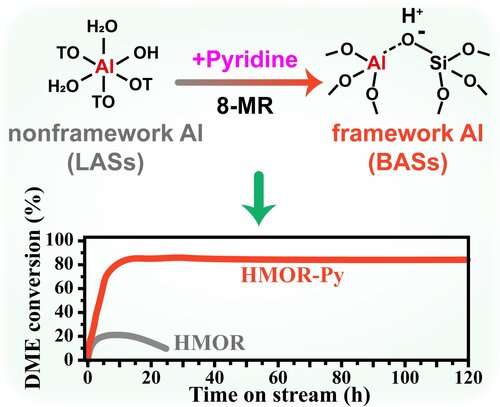Dynamic evolution of aluminum coordination environments in mordenite zeolite

Zeolites are important in many chemical synthesis and petrochemical processes. The economic and environmental requirements motivate the persisting exploration of the zeolite structure-performance relationship and the rational design of catalysts.
Recently, a research team led by Prof. Liu Zhongmin from the Dalian Institute of Chemical Physics (DICP) of the Chinese Academy of Sciences (CAS) revealed the dynamic evolution of aluminum coordination environments in mordenite (MOR) zeolite.
The study was published in Angewandte Chemie International Edition on August 1.
The researchers found that a facile treatment with pyridine could force the octahedral coordination Al back into a tetrahedral environment, which could increase the number of available active sites and enhance the diffusion of dimethyl ether, thus improving (by four times) the reactivity of the dimethyl ether carbonylation reaction and prolonging the lifetime of catalysts.
Then, they investigated the dynamic evolution of aluminum coordination environments in mordenite zeolite along with treatment conditions.
They found that all Al species adopted tetrahedral framework coordination in the NH4-MOR sample. NH4-MOR transformed into proton form after calcination, leading to the formation of Brønsted acid sites (BASs). Meanwhile, part of the framework tetrahedral Al was changed geometry into the octahedral coordination, which was demonstrated as framework-associated Al, yielding Lewis acid sites (LASs).
Upon pyridine adsorption, different Al species in distinct 8-membered ring (MR) and 12-MR topological spaces occurred complex interactions with pyridine. In the 12-MR channel, the pyridine molecule bonded with BASs, forming BASs-pyridine, thereby poisoning the acid sites. Moreover, pyridine acted on the octahedral coordination Al species, causing the LASs-pyridine species, which converted the nonframework Al species into tetracoordination.
They observed the adsorption and desorption behaviors of pyridine on the BASs within the 8-MR channel, and found that there was no effect on the BASs within 8-MR channels by pyridine in this pyridine adsorption condition. In contrast, adsorbed pyridine forced the octahedral coordination Al species in the 8-MR back into the zeolite framework, thus yielding more BASs in the 8-MR channel.
Therefore, the pyridine adsorption was helpful in obtaining a MOR catalyst with more framework Al atoms in the 8-MR channel, and the acid sites in the 12-MR channel were deactivated, thereby enhancing the dimethyl ether conversion and prolonging the lifetime of protonic MOR zeolite.
More information: Rongsheng Liu et al, Dynamic Evolution of Aluminum Coordination Environments in Mordenite Zeolite and Their Role in the Dimethyl Ether (DME) Carbonylation Reaction, Angewandte Chemie International Edition (2022). DOI: 10.1002/anie.202210658
Journal information: Angewandte Chemie International Edition
Provided by Chinese Academy of Sciences



















